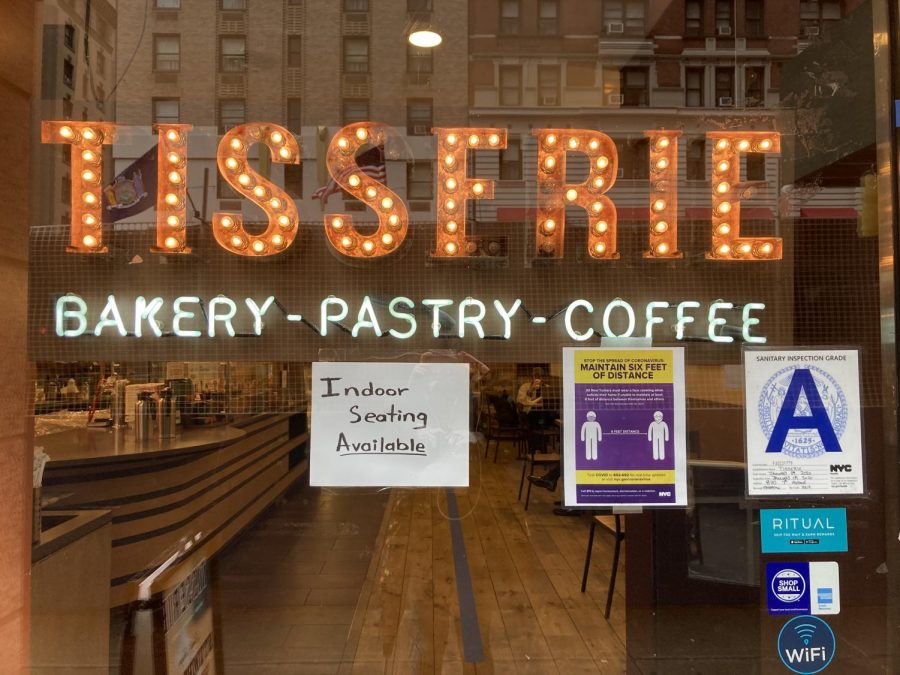Indoor Dining Reopens in NYC For the First Time In Seven Months
As New Yorkers prepare for their first restaurant meals indoors, many wonder if it’s worth the risk
Restaurants hope to reopen indoor dining after months of forced closures due to COVID-19, but they’ll have to not only adhere to social distancing guidelines, but to convince customers that it’s safe to dine inside.
October 14, 2020
For the first time in seven months, restaurants are able to serve customers indoors again. On Sept. 30, New York Gov. Andrew Cuomo allowed restaurants to reopen their doors for limited indoor dining.
Since COVID-19 lockdowns were enacted in New York City on March 16, restaurants have been forced to offer solely takeout and, since June 22, outdoor dining, if feasible.
But with cases reemerging in the city, indoor dining has very quickly become a point of concern as customers and restaurant owners are forced to learn how to navigate going back indoors safely after months of being told to stay outside.
Further, with winter quickly approaching and the city getting colder, restaurants are facing mounting pressure to allow patrons inside.
Indoor dining, like all indoor activities, has been tightly regulated during the COVID-19 pandemic as there is an increased risk of infection indoors. Airborne viruses like COVID-19 are spread through tiny droplets when an infected individual coughs or sneezes. These virus-laden droplets can linger in the air from minutes to hours, depending on how ventilated the space is.
Health experts recommend dining outdoors because droplets containing the coronavirus are easily dispersed by wind outside and are far less likely to end up being inadvertently breathed in.
Studies by the Centers for Disease Control and Prevention (CDC) highly encourage people to ensure that the restaurant they’re going to is following preventative guidelines and to eat outside if possible.
In Phase 4 of reopening, restaurants are able to open their indoor spaces to customers, provided they don’t exceed 25% of their total capacity, which will vary depending on the indoor space.
Restaurants are among the industries most heavily impacted by the COVID-19 pandemic, with over 2,800 small businesses being forced to close indefinitely since March, of which at least a third were restaurants.
NYC is also requiring restaurants to check each customer’s temperature before entry, to keep contact information from at least one customer per table to allow for contract tracing, and to have staff and customers stay 6 feet away from each other and wear masks.
Other rules require restaurants to keep bar tops closed for seating and ensure that tables have adequate space between each other. Some restaurants have redesigned their seating plans or added Plexiglas between tables to accommodate the new guidelines.
While restaurants are doing their best to serve people safely indoors, many are still hesitant about eating inside.
Bryan Hutcheson, Fordham College at Lincoln Center (FCLC) ’22, said he won’t be dining indoors anytime soon. “Even if restaurants are operating at reduced capacity, it only takes a single infected person to spread COVID-19,” said Hutcheson, who has been ordering food to go when he’s not preparing his own meals.
If restaurants were to distance indoor seating by more than 6 feet, Hutcheson said he would feel more comfortable. “But I’m not even considering it yet,” he said.
New York isn’t immune to COVID-19 infections, despite being in Phase 4. Clusters of COVID-19 outbreaks have been reported in New York City over the last several weeks, specifically in neighborhoods in Brooklyn and Queens.
These neighborhoods have been designated one of three color codes: yellow, orange or red. Each designation provides more stringent guidelines and may initiate lockdowns. For instance, a neighborhood in a yellow zone can still provide outdoor dining and open schools. In comparison, in a red zone, neighborhoods are forced to shutter all non-essential businesses, with only takeout from restaurants — no indoor or outdoor dining.
The guidelines also state that indoor dining may shut down again if the city reaches an infection rate of 2%, meaning at least 2% of COVID-19 tests given in a day are positive.
In spite of the many risk factors that come into play with virus transmission, health experts agree that the best way to avoid getting sick in the first place is to remain 6 feet away from others, to wear a mask and to wash your hands. The World Health Organization has warned against the “three C’s” in particular: closed, crowded and close-contact environments.
Restaurants are among the industries most heavily impacted by the COVID-19 pandemic, with over 2,800 small businesses being forced to close indefinitely since March, of which at least a third were restaurants. Outdoor dining has proven to be a lifeline for many struggling restaurants, and Mayor Bill de Blasio plans to extend the program at least through the rest of the year.
Although restaurants may now offer indoor dining, whether or not customers feel safe eating indoors is another matter entirely.












